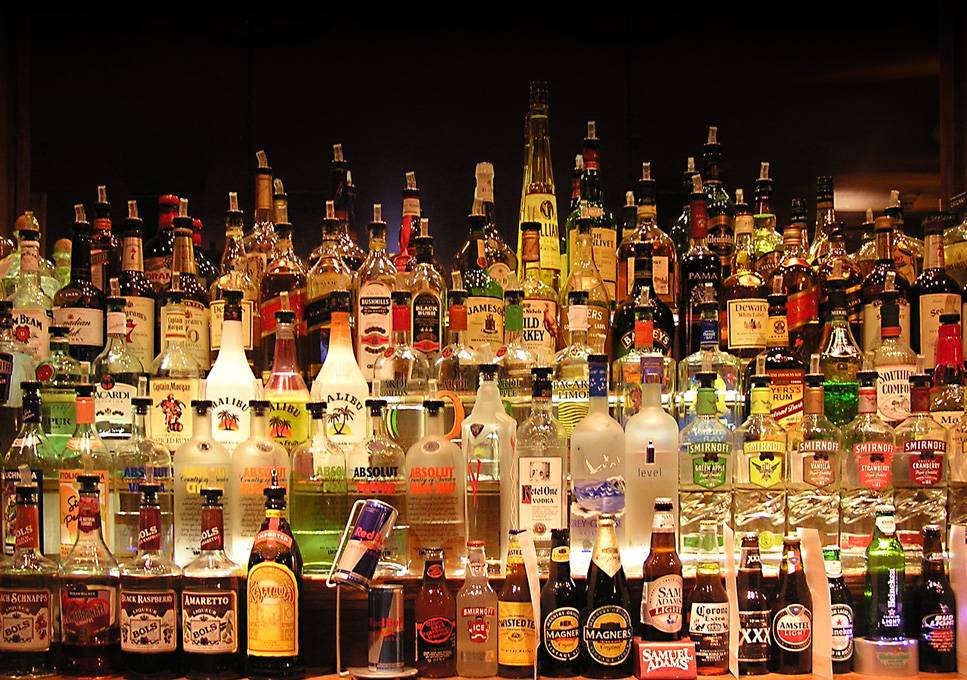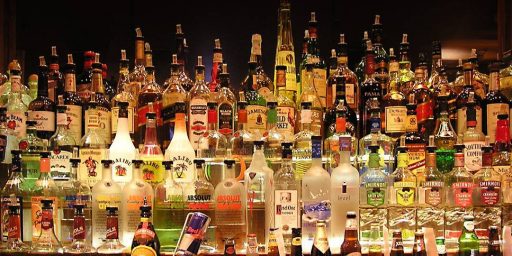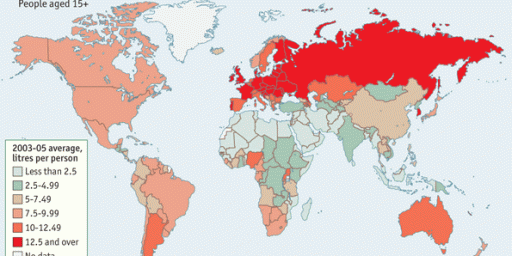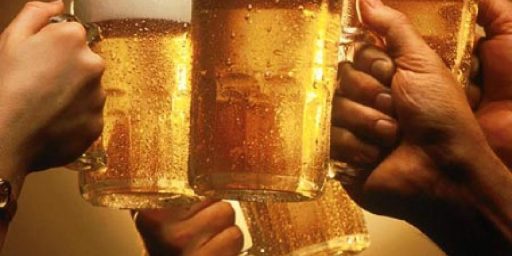Japanese Government: Drink More Sake!
When you tax sin, you need more of it.

Guardian (“Japan launches nationwide competition to boost alcohol consumption“):
The Japanese government has launched a nationwide competition calling for ideas to encourage people to drink more alcohol after a change in attitudes among the young resulted in a slide in tax revenues.
The Sake Viva! campaign, which is being run by the National Tax Agency (NTA), asks 20- to 39-year-olds to come up with proposals to help revitalise the popularity of alcoholic drinks, which have fallen out of favour because of lifestyle changes during the coronavirus pandemic and among young people.
The competition, which runs until 9 September, calls for “new products and designs” as well as ways to promote home drinking. Entrants are also encouraged to explore sales methods using the metaverse, according to local website JiJi.com.
The NTA said alcohol consumption in Japan had fallen from an average of 100 litres a person a year in 1995 to 75 litres in 2020. The decrease in alcohol sales has hit Japan’s budget, which is already running a deficit of more than ¥48tn (£290bn)
Taxes on alcohol accounted for 1.7% of Japan’s tax revenue in 2020, down from 3% in 2011 and 5% in 1980. Total revenue from tax on alcohol in the 2020 financial year fell by more than ¥110bn to ¥1.1tn, compared with the previous year, the NTA said earlier this month. It was the biggest fall in alcohol tax income in 31 years, according to the Japan Times.
“As working from home made strides to a certain extent during the Covid 19 crisis, many people may have come to question whether they need to continue the habit of drinking with colleagues to deepen communication,” an official at the agency told the English-language newspaper at the time. “If the ‘new normal’ takes root, that will be an additional headwind for tax revenue.”
This is both amusing and frightening.
While I personally pay my fair share—and that of a couple of others—of alcohol taxes, I’m pretty sure that governments shouldn’t be encouraging their citizens to drink more of it, given that some number will become alcoholics and a larger number will suffer ill health effects.
At the same time, this is what happens when you structure the revenue stream around “sin taxes.” Governments simultaneously want us to smoke, drink, and speed less but rely on the fees they impose on those who do those things to fund basic services. That creates bad incentives. It’s a big reason why liquor stores were an “essential” business during the COVID lockdowns.






A sin tax either generates revenue or reduces consumption of the products or services it targets. It cannot do both.
“Governments simultaneously want us to smoke, drink, and speed less but rely on the fees they impose on those who do those things to fund basic services.”
And play the lottery more (Nature’s tax on fools, as Ben Franklin called it).
Which is how we got the 16th Amendment which authorizes a national income tax. During the decades long campaign for Prohibition, it became clear that a substitute for alcohol taxes was needed. So the Temperance Movement pushed for the Constitutional Amendment so the revenues could be replaced.
Later on, the big pushers to repeal Prohibition were the very wealthy who despised the income tax.
BTW, a great history book about the Temperance movement and Prohibition is Last Call: The Rise and Fall of Prohibition by Daniel O’Krent. It is a great cultural history as well of the US from around 183o-1930.
A hundred liters a person!? Even 75? I assume that’s liquor, not alcohol content, but still. Even sake, which I see is 40 proof, that seems like a lot.
At 1.7% of total tax revenue, no amount of increase is going to make much difference to the deficit. But somewhere in the bureaucracy there’s a department charged with raising alcohol tax revenue, and public health is not part of their responsibilities.
@Scott: Sounds like an interesting book. Any time a city looks at increasing the number of liquor licenses, it’s opposed by a coalition of religious leaders and current license holders.
I lived in Dallas for a couple years around 1970. Blue laws were still in effect. When I first moved in I went to a grocery store on Sunday to stock my empty apartment. I grabbed a six-pack and some glasses, figuring they might not sell me the beer. The beer was OK, they wouldn’t sell me the glasses. Beer was groceries, which they could sell on Sunday. Glasses were hardware, no Sunday sales. I was told the law was largely supported by local store owners who felt a ban on Sunday sales kept the national chains out. I was in a dry county, which meant no liquor, but beer and wine 24/7 within a mile anywhere.
@gVOR08: How about if it includes beer? Even then, it’s probably still a lot–at least to me, but I remember talking to a Korean professor I tutored in English one day. He was “not feeling well” (hung over) but he understood why. He’d gone drinking with his friends–about 4 or 5 guys. They’d consumed 10 or 12 liters of beer 6 bottles (probably pints) of soju (19.6% a.b.v) and a bottle of scotch (probably a fifth, but maybe a pint–scotch is expensive at bars).
On nights that I would go to parties in bars with my professor friends in Daejeon, it wasn’t unusual for me to drink half a dozen or more drinks–usually gin and tonics or Jaegerbombs. But I don’t drink at home. Two years ago, Luddite bought me an 18 pack of cider for my July birthday. I drank the last can this past spring. A fifth of rye/rum/gin is about a year’s supply.
A society that binge drinks as a social activity will have problems with tax base stability if people start getting sick and can’t go out to drink.
@gVOR08: When I was in graduate school in Austin in the 1970s, the blue law that applied to big box stores was that the store could be open seven days a week, but nothing in the store could be for sale more than six of those days. (They had previously lost in court on the issue that closing the stores for the Christian Sabbath was discriminatory and caused significant hardship for people who observed the Jewish one.)
The K-Mart closest to the student ghetto where I lived put up a long velvet rope running from front to back of the store and announced that stuff to the left of the rope was not for sale on Tuesdays, and stuff to the right of the rope was not for sale on Wednesdays. On the two big shopping days of the week — Saturday and Sunday — the entire store was open.
Not too long after that the local government gave up on blue laws altogether.
@gVOR08: it’s only the highest proof sakes that come in at 40 proof. Most sakes are 12%-16%. The traditional drink in Japan to get drunk (especially down south) is shochu, which is a much stronger potato hooch. And then you can always go for awamori from Okinawa, which we always tagged as “rocket fuel” and is the closest you’ll get to vodka.
(Actually, the Japanese alcohol industry has been trying to make shochu an “acceptable drink” for all the salarymen for YEARS and has been having little luck. The stuff is hooch, no matter how you slice it. It’s been “the drink of the labouring man” for years and they’re never going to get past that. Plus, it burns the back of your throat.)
@grumpy realist: The Japanese distilleries should discuss with Jinro regarding getting better recipies. Korean soju is roughly the same drink as shochu (it even has the same name etymologically) but is more drinkable based on what you describe. It’s still crap, but drinkable crap (in the same vein as Rainier or PBR being a nice drink on a hot summer’s day, but not what “serious” people (the ones with liver damage even though they “only drink beer”) call beer.
I used to laugh at my foreign friends saying “soju is, like, the Kryptonite of alcoholic beverages.” The first time I tried it, I said, “yeah, I get it; vodka and water premixed.”
@grumpy realist: Reading the article, awamori sounds similar to Andong soju. Andong being the city in which it is still made and where the soju museum is. And also, much like the Okinawa/awamori connection seems to be, the only place where one can consistently find it.